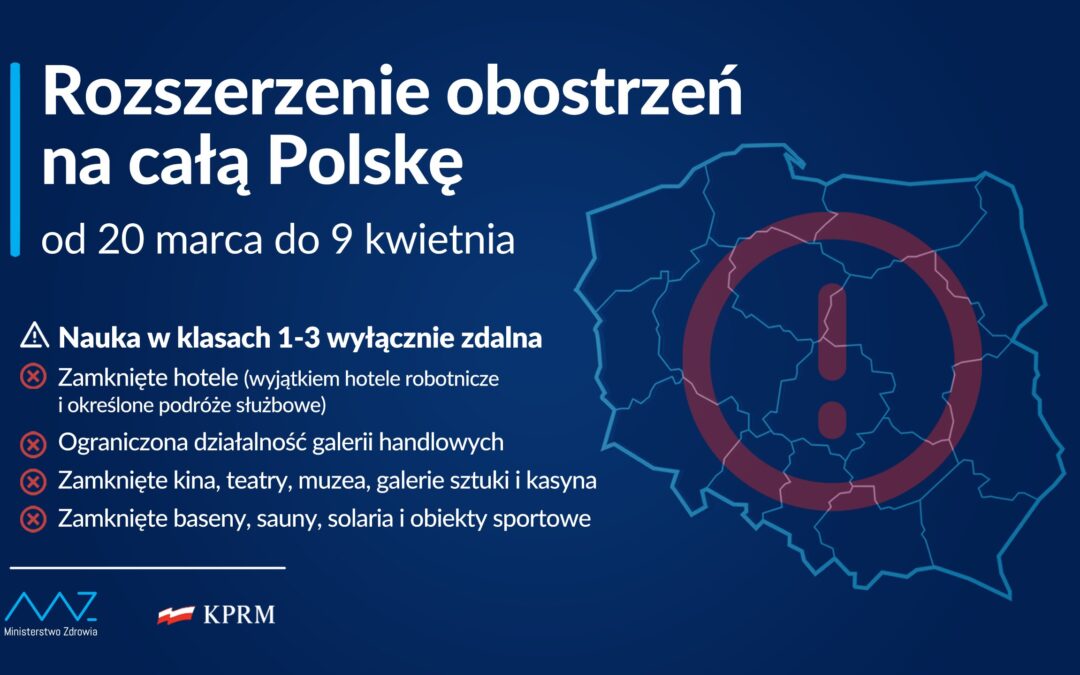Poland will return to full lockdown on Saturday, extending current restrictions in some regions to the entire country. The new rules mean that recently reopened hotels, as well as cultural and sports venues, will close and the youngest children will return to remote learning.
The new lockdown will come into force on 20 March and remain in place until at least 9 April, announced the health minister, Adam Niedzielski, during a press conference on Wednesday afternoon.
Minister @a_niedzielski w #KPRM: Podjęliśmy decyzję żeby obostrzenia regionalne wprowadzić na terenie całego kraju.
— Ministerstwo Zdrowia (@MZ_GOV_PL) March 17, 2021
Hotels, cinemas, theatres, museums and galleries will be required to close, as well as swimming pools, ski slopes and most stores in shopping centres. The youngest three year groups – who returned to in-person teaching in January – will now go back to remote learning, which older pupils are already doing.
The decision effectively returns Poland to the lockdown that was in place between November and January, when the government began to loosen restrictions after a decline in coronavirus infections following the autumn second wave.
Fitness centres and gyms remain closed, as they have been throughout the last few months, but nurseries and preschools will be exempt from closure.
Hairdressers, beauty salons, banks and laundry services will also be allowed to operate, while in shopping centres exemptions to closure will be made for grocery stores, pharmacies, press salons, book stores and construction stores. Churches may also continue to admit one person per 15 square metres of space.
The number of COVID-19 patients on ventilators (green line) in Poland is now the highest it has been since the start of the pandemic pic.twitter.com/znlVjwo3K2
— Notes from Poland 🇵🇱 (@notesfrompoland) March 17, 2021
Poland today recorded its highest daily number of new COVID-19 cases, 25,052, since November, continuing a recent upward trend. The number of patients requiring ventilators is now at the highest it has been since the start of the pandemic.
The British strain of the coronavirus, which is between 40 and 70% more infectious as well as 62% more deadly, is now estimated to account for 52% of all new cases in Poland.
As cases began to rise last month, the government started to reintroduce tougher restrictions in regions with high infection rates. Those have now been extended nationwide.
“Hard times are coming,” said Niedzielski, noting that Poland could reach a daily infection rate of 30,000 next week “and maybe even earlier”. This would threaten the country’s healthcare system, he warned.
If that happens, further steps – such as a “total lockdown” whereby “everything will be closed” – could be taken ahead of Easter, said the minister.
Last week, Poland’s National Health Fund (NFZ), which finances the public healthcare system, recommended that hospitals suspend planned procedures to ensure there is enough capacity for COVID-19 patients.
This week, the health ministry changed its rules on testing to allow those who suspect they could be infected to obtain a test via an online questionnaire without requiring a consultation with a doctor.
Main image credit: PremierRP/Twitter

Maria Wilczek is deputy editor of Notes from Poland. She is a regular writer for The Times, The Economist and Al Jazeera English, and has also featured in Foreign Policy, Politico Europe, The Spectator and Gazeta Wyborcza.




















